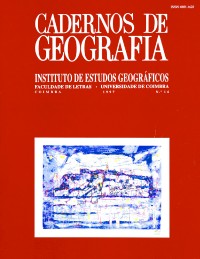Please use this identifier to cite or link to this item:
https://hdl.handle.net/10316.2/40471| Title: | O Baixo Mondego: um pouco de História | Authors: | Coelho, Maria Helena da Cruz | Keywords: | Rural Landscape;Landscape Humanization;Historical Construction of Landscape;Paisagem Rural;Humanização da Paisagem;Construção Histórica da Paisagem | Issue Date: | 1997 | Publisher: | Faculdade de Letras da Universidade de Coimbra | Abstract: | Nesta breve resenha histórica, procuraremos evidenciar os traços mais marcantes da paisagem humana do Baixo Mondego em tempos medievais, sintetizando alguns aspectos desenvolvidos na nossa tese de doutoramento O Baixo Mondego nos finais da Idade Média.
Fixar-nos-emos, de início, num tempo de crescimento das gentes e da terra, entre os séculos XI e XIII, em que se desenham os senhorios, marcos enquadradores dos homens neste espaço, nascem ou crescem os povoados e se sucedem os arroteamentos. Investe-se na cultura dos campos, arrancados às águas pantanosas ou às florestas. Cobrem-se, então, as adémias e os montes, em ambas as margens do Mondego, de vilas e aldeias. Os interesses de senhores e camponeses convergem, neste objectivo de cultivar e colonizar, reinando um clima de entendimento.
Deter-nos-emos, em seguida, sobre os tempos de dificuldades - fomes, pestes e guerras -, que se abateram sobre os homens, nos séculos XIV e XV. Procuraremos, então, detectar as marcas da crise na paisagem agrária, na produção e no relacionamento entre os privilegiados e o campesinato. Sem esquecer o diálogo reavivado da cidade com o campo, fruto de um incremento urbano e de uma maior dinâmica de circulação e comercialização dos produtos da terra e do mar, numa economia de mercado.
Chegaremos, por fim, ao quadro paisagístico e humano que da medievalidade dará passagem aos tempos modernos, onde se evidenciarão, talvez mais que as mudanças, as estruturais permanências em tendência longa. In this short historical account we hope to indicate the most important signs of the human occupation in the landscape of the Baixo Mondego (Lower Mondego) in Medieval times, synthesising some aspects that are described in greater detail in my Ph. D. Thesis, O baixo Mondego nos finais da Idade Media (The Lower Mondego at the end of the Middle Ages). We start at a time of expansion, in terms of both peoples and land, between the 11th and 13th centuries. It was a period when the "senhorios" (lands under seigneurial jurisdiction) were starting to emerge, marking out men boundaries in this space: new settlements sprang up and existing ones grew, and cultuvation of new lands then began. Fields were cultivated, snatched from the swampy waters and the woodlands. Towns and villages spread across the lowlands and hills on both banks of the Mondego. The interests of seigneurs and peasants converged in their aim of cultivating and colonising, and a climate of understanding prevailed. Then we encounter hard times: famines, plagues and wars afflicted populations in the 14th and 15th centuries. We thus sought signs of crisis in the agricultural landscape, in production and in the relations between the privileged classes and the peasants. Not forgotten, however, is the renewed dialogue between the city and the countryside, fruit of urban growth and the increased dynamic of circulation and commercialisation of products from both land and the sea, in a market economy. Finally we come to the landscape and human picture that emerged from the middle ages, moving towards modern times, where we see, possibly more than change, a structural durability with a tendency to last. |
URI: | https://hdl.handle.net/10316.2/40471 | ISSN: | 0871-1623 2183-4016 (digital) |
DOI: | 10.14195/0871-1623_16_5 | Rights: | open access |
| Appears in Collections: | Cadernos de Geografia |
Files in This Item:
| File | Description | Size | Format | |
|---|---|---|---|---|
| o_baixo_mondego_um_pouco_de_historia.pdf | 4.91 MB | Adobe PDF |  |
Items in DSpace are protected by copyright, with all rights reserved, unless otherwise indicated.
